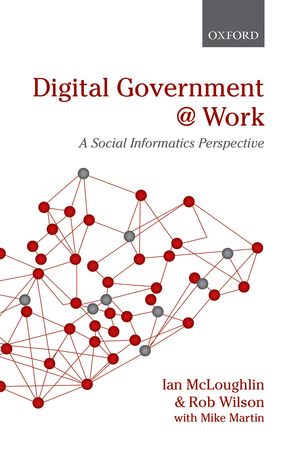Book Review: Digital Government @ Work: A Social Informatics Perspective
Digital Government @ Work examines the move toward online public services, which has been focus of huge policy and financial investments over the past decade. Based on original research into major public sector projects, Ian McLoughlin, Rob Wilson and Mike Martin offer a critique of the development of digital government. Chi Onwurah MP finds the book has a great deal of relevance for public policy, particularly in considering the need for technology to empower rather than constrain its users.
Digital Government @ Work: A Social Informatics Perspective. Ian McLoughlin and Rob Wilson, with Mike Martin. Oxford University Press. July 2013.
In the 1990s and 2000s tech cynics would often quote Robert Solow’s 1987 quip, ‘You can see the computer age everywhere but in the productivity statistics.’ Now that value chains have been disintermediated and dependent business models trashed, it is less common to hear that. However it would still be appropriate to say ‘You can see the digital age everywhere but in Government.’ Certainly in a recent Policy Exchange report, the Prime Minister’s former digital advisor Rohan Silva did his best to portray the public sector as an digitally backward captured client of ICT oligarchs now being reluctantly dragged into the 21st Century.
That makes the timing of Digital Government @ Work by Ian McLoughlin, Rob Wilson and Mike Martin all the more fortuitous. The book seeks to give the reader a broad evidence-based understanding of what digital Government can be, what it is, and the challenges it faces. It is largely successful. Steve Halliday, President of Society of Information Technology Management describes the book as ‘a rigorous and thought-provoking analysis of the history and the future of digital government,’ and I would agree with that analysis. Despite lengthy definitional discussions and dense referencing, the book is also very readable and what is more, should be read.
Here I must declare an interest: Dr Wilson is the Director of the Centre for Knowledge, Innovation, Technology and Enterprise (KITE) at Newcastle University in my constituency, while Professors McLoughlin and Martin are Visiting Fellows. Additionally, as Shadow Minister for Digital Government I have a keen interest in strengthening the critique of the current Government’s digital policy whilst developing the evidence base for what I hope will be the next. However as an ICT engineer for over 20 years my mistrust of simple technology-led solutions is deeply embedded, as is my dislike for techno-academic ‘cyberbole’.

The social informatics perspective of the book means its outlook is neither entirely technology-driven – whatever the problem the right system can solve it – nor purely qualitative, but combines understanding of the technology and its social and organisational impact with an analysis of the interdependencies at play in the context of public service delivery. These are illustrated by detailed case studies from Children’s Services, the National Programme for Local e-Government (FAME) and telecare, which highlight failings in current approaches to what they call ‘technology enactment’ as well as the – possibly systemic – challenges to real organisational and service innovation.
In Chapter 3 the authors look at the traditional ‘e-government’ aim of ‘virtual agency’ integration. They conclude this is as impossible as it is undesirable, and question the validity of applying a firm level private sector model across Government: ‘To persist with the idea that information is best shared by treating it as a commodity to be placed in a database and then accessed as required is, we believe, a potentially dangerous and threatening trend.’ But that is the very assumption – data as the new oil, the new utility – which underlies many emerging business and digital government models as well as the privacy fears of the Big Data sceptics.
In Chapter 5 the argument is expanded to consider the appropriateness of a Consumer Relationship Management (CRM) based approach, questioning whether the notion of consumer ‘embraces all aspects of the connection they [citizens] feel with public services’. When delivering public services we need to know the nature, relationships and context of all the players before determining the appropriate identity and information governance, the authors conclude. In this way the repeated polarisation between the ‘service state’ and the ‘surveillance state’ can be overcome.
This idea of a kind of context based quantum information governance – where, Shrodinger’s cat-like, what is seen depends on who is viewing and their status – is challenging technically and organisationally, but powerful in the opportunities for dramatic and disruptive government change it could unleash. Because so far, despite all its promise, digital government has entrenched existing power relationships rather than disrupting them.
The conclusions in the final chapter ‘Making Digital Government Work’ resonate strongly with my experience of private sector ICT roll-out, although they are at times opaquely expressed. Most important is the recognition that technology only empowers when we feel ownership of it, not controlled by it. If digital government is to be about empowering and improving that critical relationship at the frontline, then the ‘street bureaucrats’ the book refers to, as well as the citizen-user and the IT manager, must all be involved in an on-going co-production of the service. Rather than traditional integration we must ‘seek alternative means of coordination such as through federation and federability.’ If this is achieved, we may look to ‘digital government maturity characterised by partnership working across a mixed economy of public, private and third sectors and supported by an infrastructure of federated information and identity management systems and shared service environments’.
Having thus defined the digital government ‘sunlit uplands’, I do wish the authors had said more about the path towards them. The next Government will be faced with the necessity of doing more, better and for less. The opportunity for digital service improvement, rather than the commoditised data integration and cost stripping we see today, is extremely attractive. Whilst there are useful case studies, the authors’ detailed analysis of the challenges – skills, organisational culture, silos, inertia, security, multi-agency service users – is not matched by detailed prescriptions. That, perhaps, is for a sequel. I look forward to reading it.
—
Note: This post represents the views of the author, and does not give the position of Democratic Audit or the London School of Economics. It was originally posted on LSE Review of Books. Please read our comments policy before commenting. Shortlink: https://buff.ly/1hRoeba
—

Chi Onwurah was elected Member of Parliament for Newcastle Central in 2010, and is a Shadow Cabinet Office Minister leading on cyber security, social enterprise, and digital government. Prior to Chi’s election she worked as Head of Telecom’s Technology at the UK regulator Ofcom, and was previously a Partner in Hammatan Ventures, a US technology consultancy. She is a Chartered Engineer with a BEng in Electrical Engineering from Imperial College London and an MBA from Manchester Business School.






 Democratic Audit's core funding is provided by the Joseph Rowntree Charitable Trust. Additional funding is provided by the London School of Economics.
Democratic Audit's core funding is provided by the Joseph Rowntree Charitable Trust. Additional funding is provided by the London School of Economics.